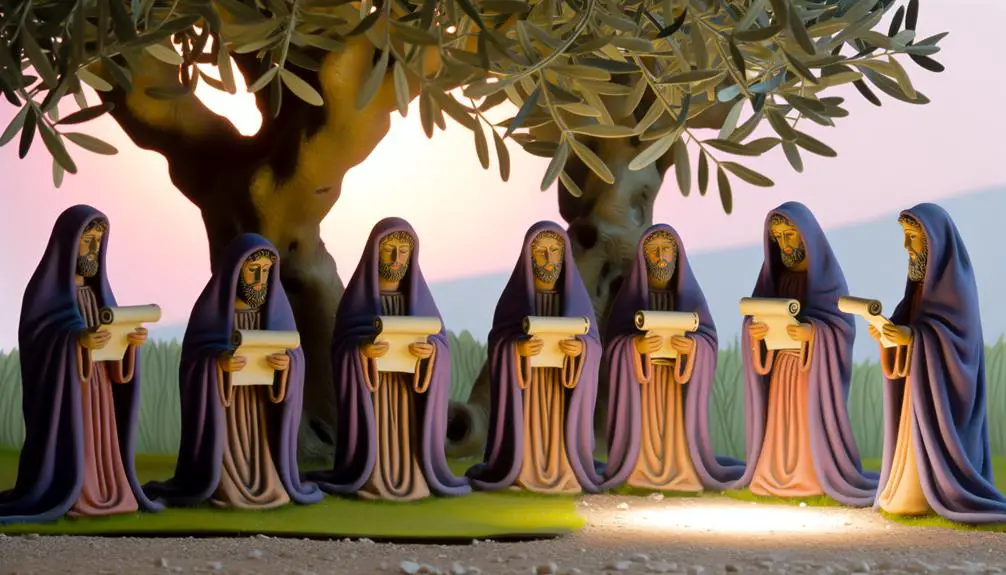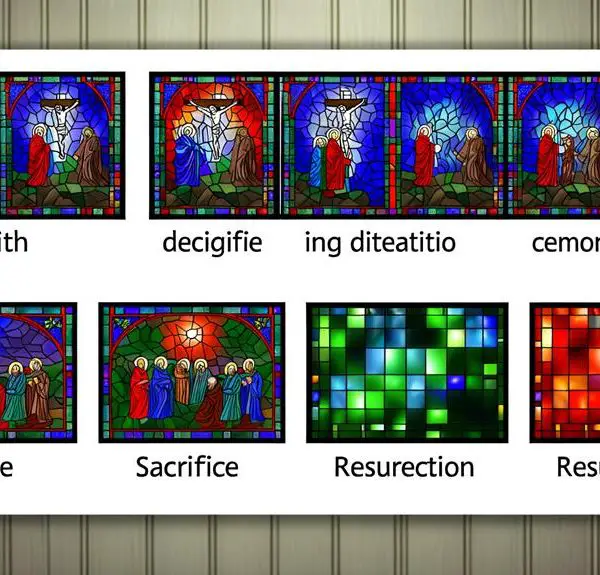The color purple in the Bible symbolizes royalty and divinity; discover why it's so pivotal in ancient texts.

Color Purple in the Bible
In the Bible, you'll find that the color purple carries deep symbolism, representing royalty, wealth, and divinity, particularly reflecting the majesty and suffering of Jesus Christ. This rich hue, sourced from the labor-intensive dyeing process using Murex shellfish, underscores its exclusivity and high status. Purple garments were worn by kings, priests, and other significant figures, marking their authority and divine favor. For example, Roman soldiers draped Jesus in purple to mock His claim to kingship, juxtaposing spiritual royalty against earthly scorn. Exploring these narratives further unravels the intricate layers of meaning attached to this vibrant color in biblical contexts.
Key Takeaways
- Purple symbolizes royalty, wealth, and the divinity of Jesus Christ in biblical texts.
- It represents both the regal status and the suffering of Jesus, highlighting his humility.
- Purple dye, extracted from Murex shellfish, was expensive and denoted exclusivity and power.
- Figures like Lydia, a merchant of purple cloth, underscore its association with authority and wealth in biblical narratives.
- Used in priestly garments, purple signifies sanctity and the solemn duty of Hebrew priests as intermediaries to God.
Significance of Purple

While purple is often associated with royalty and wealth, in the biblical context, it symbolizes both wealth and the divinity of Jesus Christ. This dual symbolism is intricately woven into both ancient texts and modern interpretations, offering a layered understanding of its significance. In the Gospels, you'll find references to purple fabric used in the robe placed on Jesus during His crucifixion, underscoring its regal connotation while simultaneously marking a poignant moment of suffering and majesty.
Artistic representations further explore this complexity. Medieval and Renaissance artworks, for instance, depict biblical figures in purple garments to denote high status and proximity to the divine. These visual interpretations reinforce the textual evidence found in the Bible, where purple is not merely a color but a symbol loaded with theological and socio-economic implications.
Contemporary scholars and theologians often emphasize purple's role in denoting Jesus' kingship in contrast to His humble earthly existence, illustrating a profound paradox. This nuanced perspective in modern interpretations helps you appreciate how historical contexts can shape the understanding of biblical elements, encouraging a deeper reflection on the texts and their artistic depictions. Therefore, purple serves as a bridge connecting the divine and the earthly, the royal and the common, across ages.
Purple in Ancient Textiles
Exploring the use of purple in ancient textiles reveals how this color's rarity and cost influenced its symbolic power in biblical times. You might find it fascinating that purple dye was not only expensive but also complex to produce, which magnified its value and significance in ancient societies. This exclusivity means that only the wealthiest or most sacred individuals could afford garments dyed in purple, a tradition well-documented in biblical scriptures.
To fully appreciate the sophistication of purple in ancient textiles, consider these elements:
- Sources of Purple Dye: The primary source was the Murex shellfish. Thousands were needed to produce just a gram of dye, making it a luxury reserved for the elite.
- Dyeing Methods: The dyeing process was labor-intensive and involved lengthy exposure to sunlight to develop the color's intensity and hue, making it a craft of skilled artisans.
- Symbolic Significance: Purple represented wealth, power, and divine connection, embedding deep cultural and religious meanings into the fabric.
- Fabric Preservation: Techniques to preserve the vibrancy of purple textiles were highly valued. These included methods to fix the dye and prevent fading, ensuring the longevity of the fabric's symbolic significance.
Understanding these aspects helps you grasp the profound impact of purple on the social and religious fabric of ancient times.
Biblical Figures and Purple

When delving into the role of purple in the Bible, it's crucial to ponder how this color signifies royalty and authority among biblical figures. You'll discover that Lydia, a prominent merchant trading in purple cloth, epitomizes the socioeconomic impact of this trade in biblical times. This hue's connection with both wealth and divine worship highlights its dual significance in ancient scriptural contexts.
Purple's Royal Symbolism
Representing regal authority and divine wisdom, purple frequently adorns biblical figures, highlighting its significance in ancient royalty and religious symbolism. This color's rich saturation communicated a visual hierarchy and spiritual depth, intertwining purple imagery with divine narratives that resonate through modern interpretations. Here's how:
- Kings and Priests: Often worn by high-ranking individuals, purple symbolized wealth and sacredness.
- Prophets' Garments: As prophets sometimes wore purple, it underscored their esteemed role and divine connection.
- Parables and Teachings: Jesus' use of purple in parables illustrated moral lessons, amplifying its symbolic weight.
- Visions and Descriptions: Revelatory texts describe figures in purple, linking it to eschatological themes and celestial authority.
Lydia's Purple Trade
In the New Scriptures, Lydia's role as a dealer in purple cloth showcases the economic and social implications of the color in biblical times. You'll find that Lydia's entrepreneurship wasn't just a matter of selling fabric; it was deeply intertwined with advanced dyeing techniques that were both costly and labor-intensive. These techniques, likely involving the use of murex snails, not only highlight the technological insights of the era but also Lydia's acumen in a trade that demanded both skill and extensive networks. Her success in this niche market underscores the high societal value placed on purple, a color often reserved for the elite. Therefore, Lydia's business did more than provide her livelihood—it reflected and reinforced the economic stratifications of her time.
Symbolism of Royalty
In the biblical context, you'll find that purple frequently underscores the majesty and high status of kings and rulers. This association is evidenced by the purple garments worn by figures such as King Solomon, symbolizing not only their royal standing but also divine favor and authority. Exploring the instances and implications of purple in royal attire enables a deeper understanding of its symbolic weight in scripture.
Purple's Royal Connotations
Purple's association with royalty is deeply embedded in historical contexts, where it symbolized power and wealth due to its rarity and cost of production. You'll find this connection not only fascinating but pivotal in understanding purple's authority and regal imagery throughout ancient civilizations.
- Exclusivity: Purple dye, derived from the labor-intensive process of extracting from sea snails, was extraordinarily expensive, making it accessible primarily to the elite.
- Legislation: In some societies, laws restricted the wearing of purple to only the royal family, reinforcing its status as a symbol of high rank.
- Visual Impact: The striking hue of purple stood out in a crowd, visually reinforcing the separation between the ruler and the ruled.
- Cultural Permanence: Over centuries, the association of purple with royalty has persisted, influencing even modern perceptions of authority and prestige.
Biblical Figures and Purple
Throughout the Bible, purple is frequently depicted as a symbol of royalty, prominently worn by significant figures to denote their high status and divine favor. This hue not only adorns royal garments but also is integral to priestly attire, underlining its sacred and authoritative undertones. When you explore the scriptures, you'll find that purple's inclusion in the vestments of high priests isn't just aesthetic. It represents a divine selection, aligning the earthly authority of priests with the heavenly majesty. This color's rarity and cost made it exclusive, reinforcing the social and spiritual hierarchy. Purple, hence, isn't just a color in the biblical context; it's a marker of both regality and the consecrated, weaving a rich tapestry of symbolism deeply embedded in the fabric of biblical narratives.
Purple Garments of Kings
Kings often donned purple garments as a vivid declaration of their sovereignty and divine right to rule. This royal attire wasn't just about aesthetics; it was deeply symbolic and integrated into the very fabric of ancient monarchy. When you picture these kingly robes, you're seeing more than just clothing. Here's what each element represented:
- Authority and Power: Purple's rarity and cost made it exclusive to the rulers, underscoring their elevated status.
- Divine Connection: Often associated with divinity, purple implied a god-sanctioned right to govern.
- Wealth and Prestige: The dye's expense signified immense wealth, reinforcing the king's ability to resource his reign.
- Cultural Significance: Across various cultures, purple holds a place of honor, further elevating the king's stature.
These aspects combined to make purple an emblem of royalty and divine favor.
Purple and the Priests
Why was purple such a significant color for the garments of Hebrew priests as described in the Bible? The color purple, associated with both royalty and the divine, played an essential role in the design of priestly garments, emphasizing their ritual significance. In the ancient world, purple dye was notoriously expensive and labor-intensive to produce, sourced from the murex shellfish. This rarity made purple fabric a symbol of high status and sacred purpose.
The Hebrew priests, serving as intermediaries between the people and God, wore garments that included purple to denote their important spiritual role. According to the biblical descriptions, particularly in Exodus, components of the priestly vestments, like the ephod and the breastplate, incorporated purple threads. These garments were not merely ornamental but held deep symbolic meanings. The inclusion of purple signified the priests' authority and their solemn duty to lead worship and perform rituals that were vital for the spiritual well-being of the community.
Thus, the use of purple in these garments reinforced the sanctity of the priests' duties, visually reminding the community of the divine service the priests were entrusted to perform. This color's use highlighted the sacredness and the solemn responsibilities bestowed upon the priesthood.
Suffering and Redemption

While the color purple symbolized the sanctity and authority of the priests, it also appears in biblical narratives as a marker of suffering and the path to redemption. This dual symbolism highlights the profound layers of meaning associated with purple in the scriptures. You might find it intriguing how this color not only denotes high status but also intertwines deeply with the themes of suffering and eventual salvation.
Here's how purple plays a role in these redemptive narratives:
- Symbol of Sacrifice: In many instances, purple garments are worn during key sacrificial motifs, signifying both the royal nature and the suffering of the sacrificial figure. This duality enhances the narrative's emotional and theological depth.
- Healing Narratives: Purple often appears in stories where healing is a central theme, underscoring the transformative power of suffering leading to a state of healing or wholeness.
- Bridge between Mortality and Divinity: Purple serves as a visual bridge in texts, hinting at the human-divine intersection where earthly suffering meets divine redemption.
- Visual Rhetoric in Parables: In parables, purple can signify the turning point from despair to hope, enriching the storytelling with layers of meaning that encourage deeper reflection on the redemptive possibilities of faith.
Through these elements, purple not only enriches the aesthetic of the narrative but also deepens the spiritual discourse on suffering and redemption in the biblical context.
Purple in Prophetic Books
In the prophetic books, purple frequently symbolizes divine judgment and sovereignty, reflecting a complex interplay of themes that demand a detailed analysis. As you explore the texts, you'll find that purple isn't just a color; it's a loaded symbol with layers of interpretative meanings rooted in prophetic imagery.
The prophets, with their vivid descriptions and metaphoric richness, use purple to not only denote royalty or high status but also to evoke a sense of impending divine intervention. For instance, the use of purple in the garments of kings in prophetic visions often prefigures the downfall or, conversely, the legitimization of their power, as ordained by divine will. This dual-use underscores the sovereignty of God over earthly kingdoms, a recurrent theme in prophetic literature.
Moreover, purple's association with judgment emerges particularly in scenes where the color adorns the city or people facing divine retribution. Here, purple paradoxically signifies both a royal dignity and an impending doom—highlighting the transient nature of earthly power and the ultimate authority of the divine. This rich tapestry of meanings invites you to look beyond the surface and consider the deeper spiritual and theological implications of purple within the prophetic books.
New Testament References

Turning to the New Writings, you'll observe that purple maintains its significance, often symbolizing both wealth and mockery within the context of Christ's passion. This dual symbolism is deeply embedded in the fabric of the narrative, where the color is not just a mere decorative element but a carrier of profound theological messages.
- Mockery of Jesus: In the Gospel of John (19:2-5), Roman soldiers cloak Jesus in a purple robe as a form of derision, mocking His claim to kingship. This act, loaded with irony, highlights the paradox of Jesus's kingship in humiliation, contrasting worldly expectations of power.
- Lydia the Merchant: Acts 16:14 introduces Lydia, a dealer in purple cloth, as one of the prominent Gentile Believers. Her profession and her conversion symbolize the spread of Christianity into the wealthier, Gentile segments of society, suggesting a bridging of cultural and economic gaps.
- Roman Centurion: The presence of the Roman Centurion at Jesus's crucifixion (Mark 15:39) and subsequent confession of Jesus as the Son of God shows a significant, albeit subtle, interaction of authority and the symbolic purple of royalty.
- Economic Symbolism: Purple dye, famously expensive and a sign of societal status, is used in various New Writings passages to denote wealth and influence, thereby setting a backdrop against which the Christian message of spiritual wealth contrasts sharply with material wealth.
Each reference unfolds layers of meaning, using purple as a theological and cultural tool to deepen the narrative of Christ's passion and the early Christian community's dynamics.
Cultural Impact of Purple
Throughout history, purple has wielded significant cultural influence, often symbolizing power and prestige across various civilizations. You've observed how this color, once reserved for the elite due to its rarity and costliness, has evolved in its significance and accessibility. In the context of the Bible, purple underscores wealth and status, particularly in the New Scripture, where it marks the attire of the wealthy and the regal.
In modern interpretations, purple's symbolism extends to represent spirituality and wisdom, influencing various cultural sectors, including fashion, art, and media. You'll notice that artistic representations often utilize purple to convey a sense of depth, mystery, and majesty, a continuation of its historical connotations but imbued with contemporary meaning. For example, in visual arts, purple is frequently used to create a mood or highlight a subject, drawing viewers deeper into the artwork.
Moreover, the color's impact is palpable in digital media where it conveys innovation and originality. This transformation from a traditional symbol of authority to a modern representation of creativity and individuality showcases purple's adaptive significance in cultural expressions. This way, your understanding of purple is enriched by observing its historical roots and its evolution in today's artistic and digital landscapes.
Frequently Asked Questions
How Is Purple Dye Created and Applied in Biblical Times?
In ancient times, you'd find purple dye created through laborious dye extraction methods from mollusks. The application techniques involved carefully treating and dyeing fabrics, ensuring rich, enduring hues in garments and textiles.
Was Purple Dye Affordable for Common People?
No, purple dye wasn't affordable for common people. It required rare resources and complex techniques, bound by royal decrees and limited by purple trade routes, symbolizing wealth and status beyond ordinary reach.
Are There Any Health Risks Associated With Purple Dye?
You should consider that some purple dyes may pose health risks, including dye allergies and significant environmental impacts due to their chemical components and the processes used in their manufacture.
How Did Other Ancient Cultures Perceive the Color Purple?
In ancient cultures, you'd find purple symbolizing royalty and wealth due to its rarity and cost. This color's cultural significance marked social status, often worn by nobility and influential figures across civilizations.
What Modern Symbolism Does Purple Hold Outside of Religious Contexts?
You'll find that purple signifies luxury and creativity due to its royal associations and impact on fashion trends. It's evolved to represent wealth and innovation in a context well beyond ancient symbolism.



Sign up